The Sandhill Crane (Antigone canadensis) stands as an emblem of grace and resilience in the avian world.
With its distinctive calls echoing across marshes and grasslands, this majestic bird captures the imagination of birdwatchers and conservationists alike.
Found across North America, the Sandhill Crane boasts a rich tapestry of behaviors, from intricate courtship displays to long-distance migrations.
Its habitat preferences, nesting habits, and social dynamics reveal a species finely attuned to wetland ecosystems and open landscapes.
Understanding the intricacies of the Sandhill Crane’s biology and behavior not only provides insights into its evolutionary adaptations but also underscores the importance of preserving its habitats and ensuring its continued existence in the wild.
Join us on a journey to explore the captivating world of the Sandhill Crane, where beauty and resilience intertwine amidst the wetlands and skies of North America. Stay sharp.
Physical Characteristics of Sandhill Crane
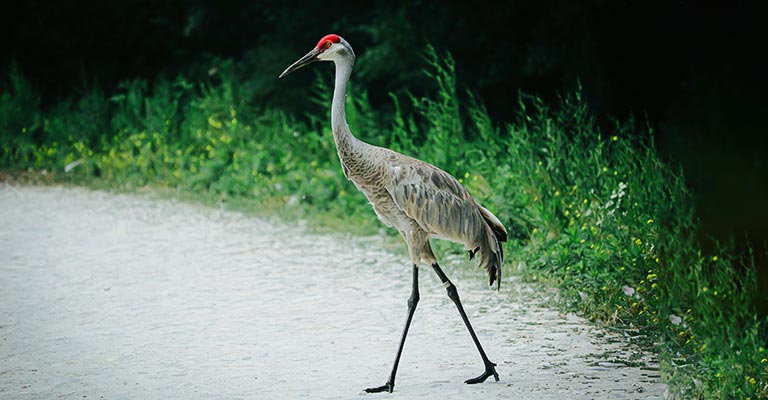
The Sandhill Crane (Antigone canadensis) is a majestic bird known for its distinctive physical characteristics.
Identifying these birds can be relatively straightforward once you become familiar with their key features. Here are some of the points to help you identify a Sandhill Crane:
Size and Shape
Sandhill Cranes are large birds, standing about 3 to 4 feet tall with a wingspan of approximately 6 to 7 feet.
They have long necks, long legs, and a long, pointed bill. Their bodies are primarily gray with varying shades, and they have a white patch on their cheeks.
Coloration
Sandhill Cranes exhibit predominantly gray plumage, which can vary from pale gray to rusty brown depending on the subspecies and age.
Juveniles tend to have a more brownish hue, while adults have a more uniform gray appearance. The plumage is often lighter on the underparts and darker on the upperparts.
Head and Neck
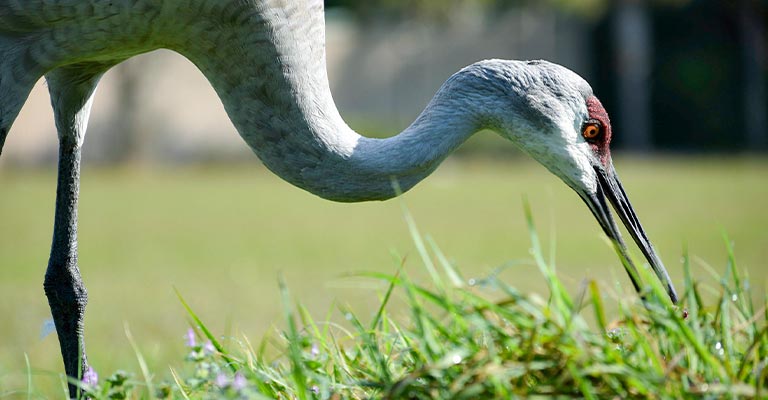
One of the most distinguishing features of the Sandhill Crane is its red crown.
During the breeding season, the skin on top of their heads becomes bright red, contrasting with their gray plumage. Their long necks are often held straight while in flight or walking.
Flight Style
Sandhill Cranes have a distinctive flight style characterized by slow, methodical wingbeats.
They often fly with their necks outstretched and their legs trailing behind. Their wingspan and overall size make them easily recognizable in flight.
Vocalizations
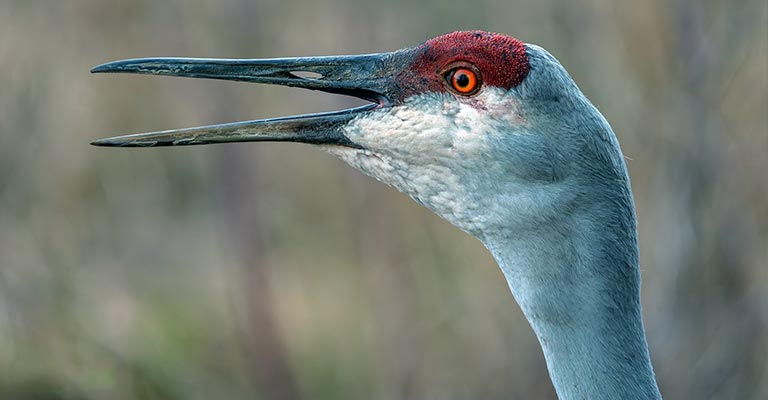
Another characteristic feature of Sandhill Cranes is their loud, trumpeting calls. These calls can carry over long distances and are often heard during their migratory flights or when they gather in large flocks.
The calls are described as deep and resonant, and they play a significant role in communication among cranes.
Habitat
Sandhill Cranes are commonly found in wetland habitats such as marshes, grasslands, and meadows. They prefer areas with shallow water for foraging and roosting sites with nearby open spaces for takeoff and landing.
Behavior
When feeding, Sandhill Cranes use their long bills to probe the ground for insects, small mammals, seeds, and plant tubers.
They may also be observed performing elaborate courtship displays, which involve dancing, bowing, and jumping.
Geographic Range
Sandhill Cranes have a broad geographic range, spanning across North America, with various subspecies occupying different regions.
They are migratory birds, with populations in the northern parts of their range migrating south for the winter. During migration, they form large flocks, making them a spectacular sight for birdwatchers.
Identifying a Sandhill Crane involves observing its size, coloration, distinctive head markings, flight style, vocalizations, habitat preferences, behavior, and geographic range.
With these key characteristics in mind, birdwatchers can easily recognize and appreciate these iconic birds in the wild.
Taxonomy of Sandhill Crane
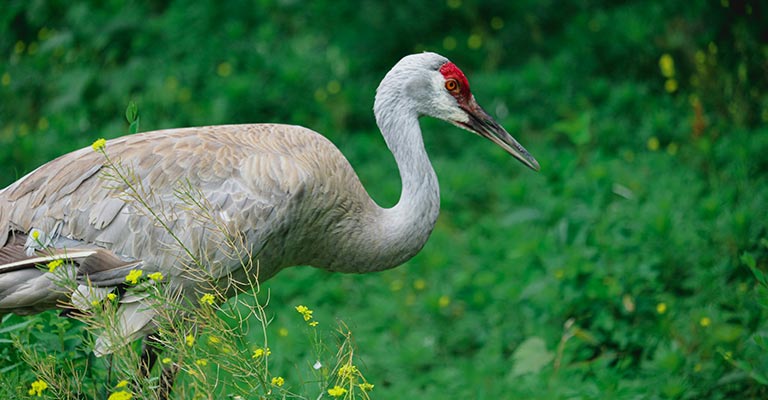
Find out the table below summarizing the taxonomy details of the Sandhill Crane:
| Domain | Eukaryota |
| Kingdom | Animalia |
| Phylum | Chordata |
| Class | Aves |
| Order | Gruiformes |
| Superfamily | Gruoidea |
| Family | Gruidae |
| Genus | Antigone |
| Species | A. canadensis |
The Sandhill Crane (Antigone canadensis) encompasses five recognized subspecies, each with its own unique range and characteristics:
- A. c. canadensis: This subspecies inhabits northeast Siberia, Alaska, and northern Canada, extending to Baffin Island. These cranes undertake extensive migrations, traveling long distances to reach their breeding and wintering grounds.
- A. c. tabida: Found in southern Canada and the western and central United States, this subspecies is well-adapted to a variety of habitats, including grasslands, wetlands, and agricultural fields. Their populations have adapted to human-modified landscapes, often foraging in agricultural areas.
- A. c. pratensis: Endemic to Georgia and Florida, the pratensis subspecies thrives in the southeastern United States. Their habitat preferences include freshwater marshes, wet prairies, and grasslands. Conservation efforts in this region focus on preserving and restoring critical wetland habitats.
- A. c. pulla: This subspecies is limited to the Mississippi region. It is known for its distinctive vocalizations and courtship displays, which play a crucial role in mate selection and pair bonding.
- A. c. Nesiotes: Endemic to Cuba and the Isle of Pines (Isla de la Juventud), this subspecies is found in freshwater and saltwater marshes, as well as agricultural areas. Habitat loss and degradation threaten the survival of Nesiotes cranes, highlighting the importance of conservation efforts in the Caribbean.
These subspecies of Sandhill Crane demonstrate the species’ adaptability to a range of habitats and environments while also facing various conservation challenges unique to their respective regions.
Common Food of Sandhill Crane
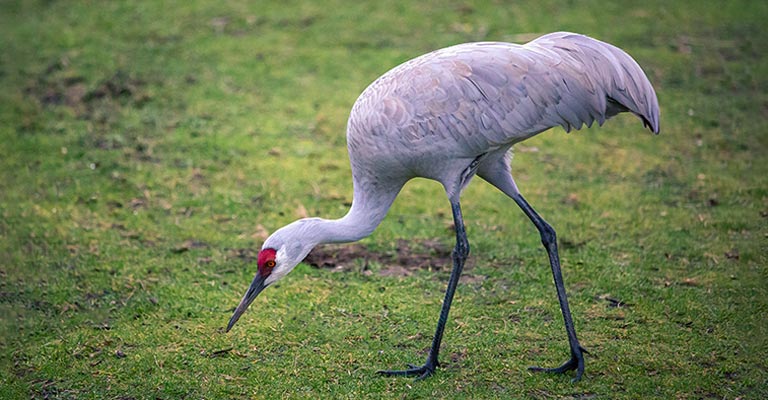
Sandhill Cranes are omnivorous birds with a diverse diet that varies based on their habitat and the season. Their common food habits include:
- Insects and Invertebrates: Sandhill Cranes feed on a wide variety of insects, such as grasshoppers, crickets, beetles, and worms, which they find by probing the ground with their long bills.
- Grains and Seeds: They also consume various grains and seeds found in their habitat, including corn, wheat, barley, and rice, especially during the fall and winter months when these food sources are abundant.
- Plant Tubers and Roots: In wetland habitats, Sandhill Cranes feed on plant tubers and roots, such as those of sedges, rushes, and aquatic plants, which they dig up with their bills.
- Small Vertebrates: Occasionally, Sandhill Cranes may consume small vertebrates like rodents, frogs, and small fish, supplementing their diet with animal protein when available.
Sandhill Cranes are opportunistic feeders, adapting their diet to the resources available in their environment throughout the year.
Sandhill Crane Life History
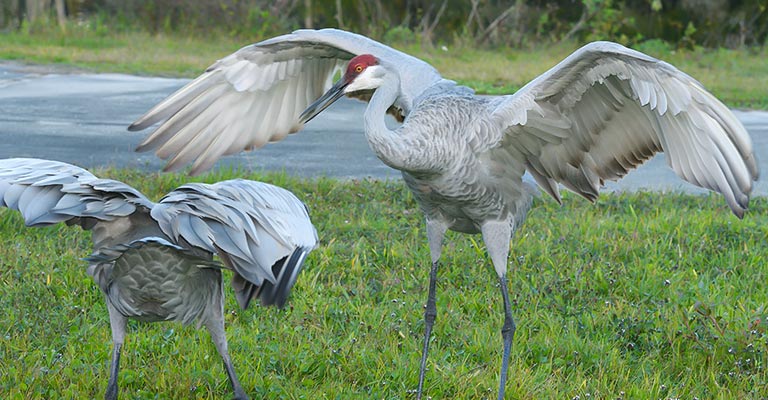
The Sandhill Crane (Antigone canadensis) is a fascinating species of bird known for its majestic appearance and distinctive calls.
Found across North America, these cranes inhabit a variety of wetland and grassland habitats, where they play a crucial ecological role.
Understanding the life history of Sandhill Cranes provides insight into their remarkable adaptations and the challenges they face in their environment.
Habitat
Sandhill Cranes primarily inhabit wetlands, marshes, grasslands, and agricultural fields. During migration, they may also utilize shallow freshwater habitats and coastal areas.
These birds rely on open spaces for foraging and roosting sites with nearby water sources for feeding and protection.
Range Map

The range of Sandhill Cranes spans across North America, with various subspecies occupying distinct regions.
They breed in northern parts of the continent, including Alaska, Canada, and the northern United States, and migrate south for the winter, reaching as far as Mexico and Florida.
Nesting
Sandhill Cranes typically build their nests in wetland areas, constructing mounds of vegetation or using existing structures such as marsh hummocks.
Nests are made from grasses, reeds, and other plant materials, and both parents participate in nest building. Females usually lay two eggs, and both parents share incubation duties for about a month until the eggs hatch.
Check out the following table detailing the nesting details of Sandhill Cranes:
| Nesting Details | Facts |
| Clutch Size | Typically 2 eggs |
| Number of Broods | Usually 1 per season |
| Egg Length | Approximately 3.5 to 4.5 inches (8.9 to 11.4 cm) |
| Egg Width | Approximately 2.5 to 3 inches (6.4 to 7.6 cm) |
| Incubation Period | Around 30 days |
| Nestling Period | 60 to 90 days |
| Egg Description | Smooth, typically tan, olive, or brown in color with irregular darker markings |
| Nest Construction | Mounds of vegetation or reeds, or use existing structures like marsh hummocks |
| Incubation Behavior | Both parents share incubation duties, taking turns to sit on the nest |
| Nest Location | Constructed in wetland areas, usually near water sources for foraging |
This table summarizes key nesting details of Sandhill Cranes, providing insights into their reproductive behavior and nest characteristics.
Sandhill Cranes typically construct their nests in wetland areas, selecting sites with access to shallow water and surrounding vegetation.
Nests are often built on mounds of vegetation or reeds, or they may utilize existing structures such as marsh hummocks.
Both male and female cranes participate in nest building, weaving grasses and other plant materials into a circular mound.
The female typically lays two eggs, which are smooth and range in color from tan to olive with darker markings. Both parents share incubation duties, taking turns to keep the eggs warm until they hatch after approximately 30 days.
Breeding
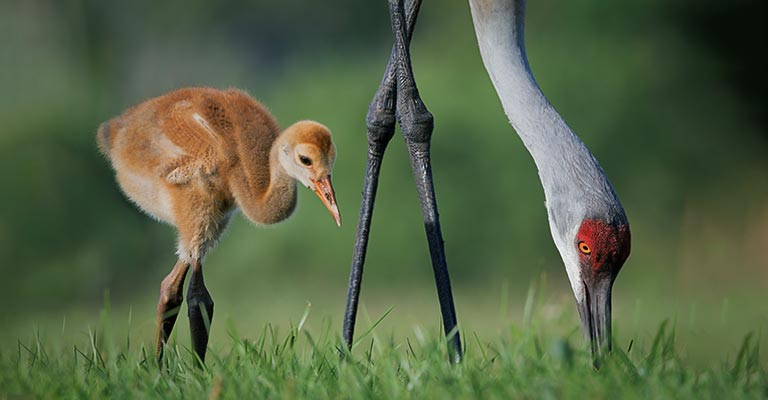
Breeding season for Sandhill Cranes typically occurs in the spring and summer months. Courtship displays involve elaborate dances, vocalizations, and aerial maneuvers, strengthening pair bonds.
After mating, the pair works together to raise and protect their young, which remain with them for several months until they can fly and fend for themselves.
Diseases
Sandhill Cranes are susceptible to various diseases, including avian influenza, West Nile virus, and botulism.
These diseases can impact crane populations, particularly during migration and when congregating in large groups. Environmental factors such as habitat loss and pollution can also contribute to disease transmission.
Treatment
Efforts to monitor and manage disease outbreaks among Sandhill Cranes involve surveillance, vaccination programs, and habitat restoration.
Veterinary care may be provided to infected individuals, and public health initiatives aim to reduce the spread of zoonotic diseases from cranes to humans.
Conservation
Conservation of Sandhill Cranes focuses on habitat preservation, sustainable management of wetlands, and mitigating human-induced threats such as habitat destruction, pollution, and climate change.
Conservation organizations work to raise awareness, conduct research, and implement conservation strategies to ensure the long-term survival of Sandhill Crane populations.
The life history of Sandhill Cranes reflects their remarkable adaptability to diverse habitats and their importance as indicators of wetland health.
By understanding their habitat requirements, breeding behavior, and conservation needs, we can better protect and conserve these iconic birds for future generations.
10 Behavioral Habits of Sandhill Crane
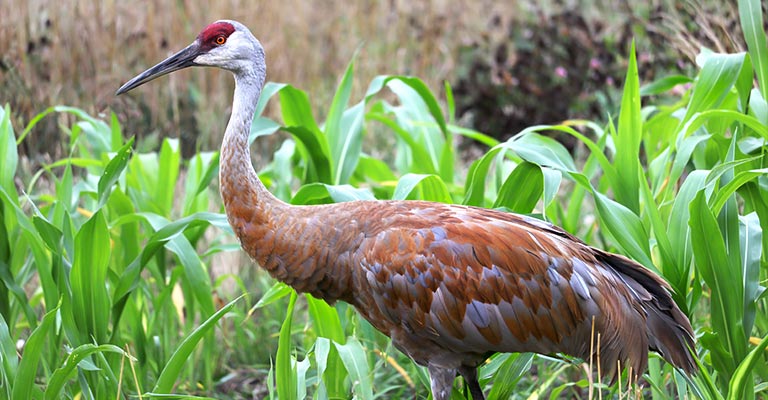
Sandhill Cranes exhibit a range of fascinating behavioral habits that contribute to their survival and social dynamics.
From intricate courtship displays to cooperative foraging, these behaviors offer insights into the complex lives of these iconic birds.
- Courtship Displays: Sandhill Cranes engage in elaborate courtship displays, which involve dancing, bowing, and vocalizations. These displays strengthen pair bonds and play a crucial role in mate selection.
- Vocalizations: Sandhill Cranes are known for their loud, trumpeting calls, which serve various purposes, including communication within flocks, territory defense, and mate attraction.
- Parental Care: Both male and female Sandhill Cranes participate in incubating the eggs and raising the young. They exhibit attentive parental care, teaching their offspring essential skills for survival.
- Foraging Behavior: Sandhill Cranes are opportunistic feeders, probing the ground with their long bills to search for insects, small mammals, seeds, and plant tubers. They may also feed on agricultural crops in human-modified landscapes.
- Agonistic Displays: When threatened or establishing dominance hierarchies, Sandhill Cranes may engage in aggressive displays such as raising their wings, lunging, or vocalizing loudly to deter rivals.
- Social Structure: Sandhill Cranes often gather in large flocks, particularly during migration and wintering periods. Within these flocks, they exhibit complex social structures, with individuals forming long-lasting bonds and hierarchies.
- Migration Patterns: Sandhill Cranes undertake long-distance migrations between their breeding and wintering grounds, following traditional flyways and utilizing stopover sites to rest and refuel.
- Territorial Behavior: During the breeding season, Sandhill Cranes defend nesting territories, engaging in aerial displays and vocalizations to deter intruders.
- Sleeping Arrangements: Sandhill Cranes often sleep while standing in shallow water or on one leg, with their heads tucked under their wings. This behavior allows them to rest while remaining vigilant for potential threats.
- Grooming Rituals: Sandhill Cranes regularly engage in grooming behaviors, preening their feathers to maintain their waterproofing and remove parasites, ensuring their plumage remains in optimal condition for flight and insulation.
The behavioral habits of Sandhill Cranes reflect their adaptability, social complexity, and survival strategies in various habitats across their range.
Studying these behaviors offers valuable insights into the ecology and biology of these magnificent birds.
Wrapping Up
So, the Sandhill Crane is a remarkable species with unique behaviors, nesting habits, and social dynamics.
From courtship displays to migration patterns, these birds exhibit a fascinating array of adaptations that enable them to thrive in diverse environments.
Understanding and appreciating the behavioral intricacies of Sandhill Cranes can deepen our connection to the natural world and inspire conservation efforts to protect these iconic birds for future generations. Thank you very much.
Meta Description: